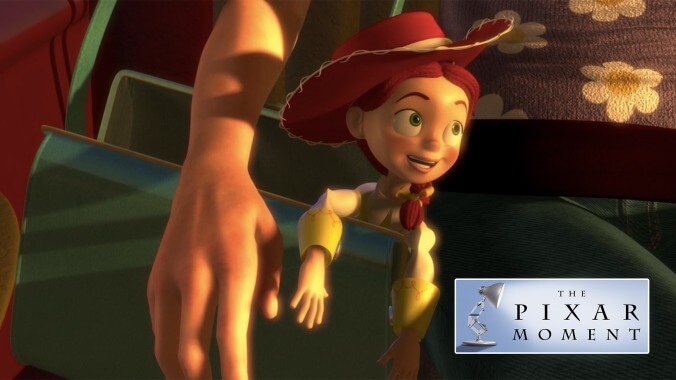Toy Story 2 was the first time Pixar tried to reduce the whole audience to a sobbing wreck
Image: Screenshot: Toy Story 2
From its inception, the Toy Story franchise has focused on cowboy Woody’s attachment to his owner, Andy. In the first movie, Woody feels threatened by the addition of action figure Buzz Lightyear to the toy stable. In the second, Woody has separation anxiety and fear of abandonment after Andy doesn’t bring him to cowboy camp due to a torn arm. We know that Woody is afraid of being left behind, but we don’t know just how the dire the stakes are until we learn Jessie’s tragic backstory in Toy Story 2.
Cowgirl Jessie (enthusiastically voiced by Joan Cusack) is a member of Woody’s Roundup, a lineup of toys—including Woody’s horse, Bullseye, and prospector, Stinky Pete—that has been stuck in storage for a long, traumatizing time. While generally good-hearted, Jessie is adamant that Woody join the gang so that they can be displayed together at a toy museum in Tokyo, and treats any mention of instead wanting to return to Andy with disdain. The reason for Jessie’s ire becomes clear in a flashback that arrives around the movie’s halfway point, accompanied by Sarah McLachlan’s rendition of the Randy Newman song “When She Loved Me.”
Just the verb tense of that song title is a heart-twister. McLachlan’s angelically high vocals deliver the pity-inducing pathos, as she describes how “When somebody loved me / Everything was beautiful.” The lighting that strikes during the sequence is especially effective, bathing everything in golden hues and lush greenery as Jessie remembers how she and her owner, Emily, were once in the throes of cowgirl-inspired play. Eventually, the inherent conflict of the toy/owner relationship emerges: The kids are going to grow up, but the toys are not (as the lyrics indicate: “So the years went by / I stayed the same / But she began to drift away”). The fact that kids don’t realize that the toys have actual feelings only adds to the (unintentional) pain they inflict.
Jessie unceremoniously tumbles from her honored position at the top of Emily’s bed to being forgotten underneath it. From her new, dusty vantage point, a bottle of nail polish looks especially foreboding. Eventually, Jessie is picked up again, but as the lyrics fervently wish for “the day when she’d say, ‘I will always love you,’” the honeyed sun dims in the late afternoon, and the tree where Jessie and Emily once played goes from green and vibrant to autumnal. In the scene’s ultimate gut-wrenching moment, instead of being played with again as she hopes, Jessie is discarded in a donation box by the side of the road, cruelly forced to gaze out at the very spot that once brought her so much happiness.
Kids might understandably tear up over Jessie’s plight, but “When She Loved Me” was an almost inevitable sobfest for the parents sitting next to them in the theater, understanding how fleeting those hallowed moments of childhood innocence are. Billboard reported that McLachlan started crying upon hearing the song for the first time, rightly predicting that “every mummy in the audience is gonna be bawling their eyes out. I don’t know about the kids, but it’s pretty hard for the mothers.” Her heartfelt delivery helped the song land both an Oscar nomination (it lost to Phil Collins’ Tarzan ode “You’ll Be In My Heart”) and a Grammy win for Best Song Written For Visual Media.
Toy Story 2 was only the third Pixar feature, and this one short segment elevated the movie from an adventurous romp (a few scenes later, kids watching would have moved on to wondering how in the world all these toys were going to get home from the airport) to a meditation on the losses associated with growing up. Pixar’s eventual parent company, Disney, had never shied away from tear-jerking moments like the death of Bambi’s mom or Dumbo’s mother singing “Baby Mine” through a cage. “When She Loved Me” immediately joined the pantheon of emotionally wrenching scenes delivered via the deceptively cheerful and brightly colorful vehicle of animation.
The accolades the scene received paved the way for Pixar to insert similarly effective moments into its animated adventures: the tragedy that kicks off Finding Nemo, for example, or the heartrending intro to Up. The ultimate lesson of Inside Out, after all, is that sad moments are as vital as happy ones; as Pixar’s John Lasseter was fond of saying, “Walt Disney always said for every laugh, there should be a tear. I have always believed in that.” The “When She Loved Me” scene brought that crucial poignancy to Pixar for the first time, making it possibly the most memorable moment in the entire Toy Story franchise. Once viewed, it’s impossible to shake, a piercing reminder of the impermanence of childhood.